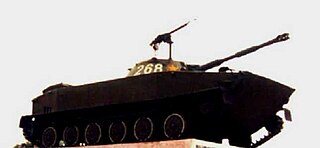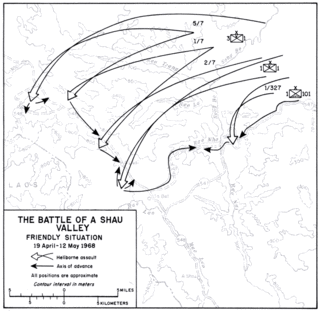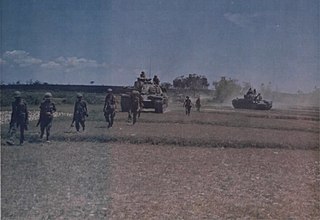
The Battle of Khe Sanh was conducted in the Khe Sanh area of northwestern Quảng Trị Province, Republic of Vietnam, during the Vietnam War. The main US forces defending Khe Sanh Combat Base (KSCB) were two regiments of the United States Marine Corps supported by elements from the United States Army and the United States Air Force (USAF), as well as a small number of Army of the Republic of Vietnam (ARVN) troops. These were pitted against two to three divisional-size elements of the North Vietnamese People's Army of Vietnam (PAVN).

The Battle of Lang Vei began on the evening of 6 February 1968 and concluded during the early hours of 7 February, in Quảng Trị Province, South Vietnam. Towards the end of 1967, the 198th Tank Battalion of the People's Army of Vietnam's (PAVN) 202nd Armored Regiment received instructions from the North Vietnamese Ministry of Defense to reinforce the 304th Division as part of the Route 9–Khe Sanh Campaign. After an arduous journey down the Ho Chi Minh trail in January 1968, the 198th Tank Battalion linked up with the 304th Division for an offensive along Highway 9, which stretched from the Laotian border through to Quảng Trị Province. On 23 January, the 24th Regiment attacked the small Laotian outpost at Bane Houei Sane, under the control of the Royal Laos Army BV-33 "Elephant" Battalion. In that battle, the 198th Tank Battalion failed to reach the battle on time because its crews struggled to navigate their tanks through the rough local terrain. However, as soon as the PT-76 tanks of the 198th Tank Battalion turned up at Bane Houei Sane, the Laotian soldiers and their families retreated into South Vietnam.

Con Thien was a military base that started out as a U.S. Army Special Forces camp before transitioning to a United States Marine Corps combat base. It was located near the Vietnamese Demilitarized Zone (DMZ) about 3 kilometers (1.9 mi) from North Vietnam in Gio Linh District, Quảng Trị Province. It was the site of fierce fighting from February 1967 through February 1968.

Operation Delaware/Operation Lam Son 216 was a joint military operation launched during the Vietnam War. It began on 19 April 1968, with troops from the United States and the Army of the Republic of Vietnam (ARVN) moving into the A Sầu Valley. The A Sầu Valley was a vital corridor for moving military supplies coming from the Ho Chi Minh Trail and was used by the People's Army of Vietnam (PAVN) as a staging area for numerous attacks in northern I Corps. Other than small, special operations reconnaissance patrols, American and South Vietnamese forces had not been present in the region since the Battle of A Shau in March 1966, when a U.S. Special Forces camp located there was overrun.

Operation Prairie was a U.S. military operation in Quảng Trị Province, South Vietnam that sought to eliminate People's Army of Vietnam (PAVN) forces south of the Demilitarized Zone (DMZ). Over the course of late 1965 and early 1966 the Viet Cong (VC) and the PAVN intensified their military threat along the DMZ. The tactical goal of these incursions was to draw United States military forces away from cities and towns. Operation Hastings, a series of actions in defense of the DMZ, lasted from 15 July to 3 August 1966. It was considered a strategic success. Operation Prairie was conceived as a larger, longer mission covering the same areas along the DMZ.

The 1st Division of the Army of the Republic of Vietnam (ARVN)—the army of the nation state of South Vietnam that existed from 1955 to 1975—was part of the I Corps that oversaw the northernmost region of South Vietnam, the centre of Vietnam.
Operation Prairie IV was an operation conducted by the United States Marine Corps in the area around Con Thien, South Vietnam known as Leatherneck Square from 20 April until 17 May 1967. During the course of the fighting Marine casualties were 164 killed 1,240 wounded while claiming 505 People's Army of Vietnam (PAVN) killed and 9 captured.

Ca Lu Combat Base was an Army of the Republic of Vietnam (ARVN) and United States Marine Corps base located on Highway or Route 9, near Krông Klang, Đa Krông District, western Quảng Trị Province, South Vietnam.
The 320th Division or Đồng Bằng Division is a formation and one of the six original "Steel and Iron Divisions" of the People's Army of Vietnam (PAVN). It was established in January 1951.
The Battle for Quang Tri occurred in and around Quảng Trị City, the northernmost provincial capital of South Vietnam during the Tet Offensive when the Vietcong (VC) and People's Army of Vietnam (PAVN) attacked Army of the Republic of Vietnam (ARVN) and American forces across major cities and towns in South Vietnam in an attempt to force the Saigon government to collapse. This included several attacks across northern I Corps, most importantly at Huế, Da Nang and Quảng Trị City. After being put on the defensive in the city of Quảng Trị, the Allied forces regrouped and forced the PAVN/VC out of the town after a day of fighting.
The Battle of Signal Hill was a company size engagement between members of Company E, 52nd Infantry (LRP) long-range reconnaissance patrol of the 1st Cavalry Division (Airmobile) and the People's Army of Vietnam (PAVN) from 19 to 21 April 1968 during Operation Delaware. Signal Hill was the name given to the peak of Dong Re Lao Mountain, a densely forested 4,878-foot (1,487 m) mountain in the A Sầu Valley. The strategic location made it an ideal communication and fire support site, vital to the success of Operation Delaware.
Company E, 52nd Infantry, (LRP) was a 120 man-sized long-range reconnaissance patrol unit attached to the 1st Cavalry Division (Airmobile) in Vietnam in 1967-69. Its origin begins on January 1, 1967, as "LRRP Detachment G2," 1st Cavalry Division (Airmobile). It was then redesignated "Headquarters & Headquarters Company LRRP Detachment" in April 1967, and redesignated "Company E, 52nd Infantry (LRP)" on December 20, 1967.

Operation Robin was a U.S. Marine Corps operation that took place southeast of Khe Sanh, Quảng Trị Province from 2–19 June 1968.
Đông Hà Combat Base is a former U.S. Marine Corps and U.S. Army base northwest of Quảng Trị in central Vietnam. The base was first used by the 4th Marines in late April 1966. In mid-July Đông Hà was used by the Marines as a helicopter base and logistics area. Numerous US marine and army units rotated through the base, and several artillery units were based there.

Cam Lộ Combat Base is a former U.S. Marine Corps, U.S. Army and Army of the Republic of Vietnam (ARVN) base northwest of Quảng Trị in central Vietnam.

Operation Jeb Stuart was a U.S. Army operation during the Vietnam War that took place in Quảng Trị and Thừa Thiên Provinces from 21 January to 31 March 1968. The original operation plan to attack People's Army of Vietnam (PAVN) base areas was disrupted by the Tet Offensive and instead it saw the U.S. Army units fighting in the Battle of Quang Tri and the Battle of Huế.
Operation Scotland II was a U.S. Marine Corps security operation that took place in northwest Quảng Trị Province from 15 April 1968 to 28 February 1969.
The DMZ Campaign (1969–71) was a military campaign by the United States Army, United States Marine Corps (USMC) and the Army of the Republic of Vietnam (ARVN) against the People’s Army of Vietnam (PAVN) along the Vietnamese Demilitarized Zone (DMZ) in northern Quảng Trị Province from 1969 to 1971 during the Vietnam War.

Operation Crockett was an operation during the Vietnam War conducted by the United States Marine Corps against People's Army of Vietnam (PAVN) forces around Khe Sanh Combat Base in northwest Quảng Trị Province that took place from 13 May to 16 July 1967. The PAVN tested U.S. defenses, forcing the Marines to deploy additional forces to the area, following which the PAVN disengaged but did not withdraw from the area. The operation resulted in 111 PAVN killed and one captured for Marine losses of 34 killed. The operation was immediately followed by Operation Ardmore, an ongoing security operation.

Operation Concordia Square was an operation conducted by the United States Army 2nd Brigade, 1st Cavalry Division south of the Vietnamese Demilitarized Zone in Quảng Trị Province. The operation ran from 8 to 17 May 1968.
























